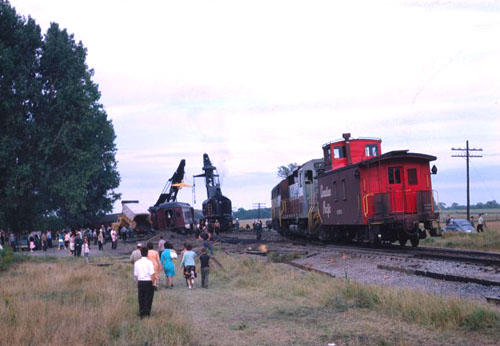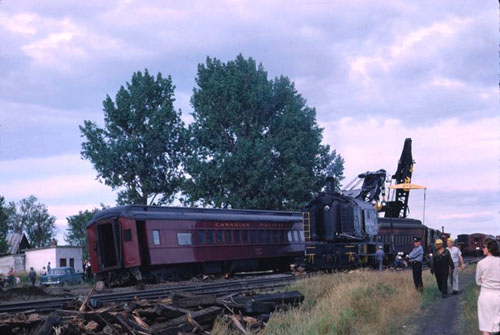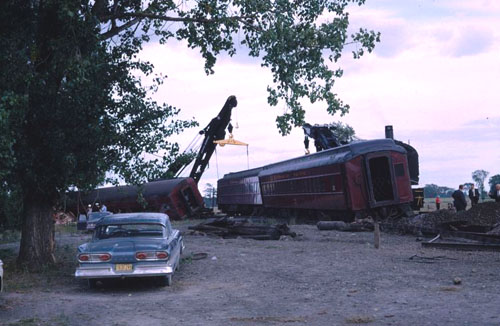Details of Railway Accidents in the Ottawa Area

1964, August 21 - Crossing collision, Leonard, CPR., Montreal and Ottawa sub., eight fataities, over 20 injured.

|
The morning express to Montreal
(No. 232)
was
struck behind the engine by a northbound [gravel] truck at the crossing
in
Leonard and the coaches and heavyweight parlour cars derailed. At
least one 2200-class
coach (no 2294) rolled on to its side and skidded several hundred feet
before coming to a stop (end-on) against large trees, the only thing
that protected an occupied CPR house. As
this coach bounced along the roadbed, passengers were
ejected through the shattered windows and crushed or severely injured. The
number killed was 8
immediate, possibly more afterwards.
Bill Linley went to the wreck scene and took these photographs:
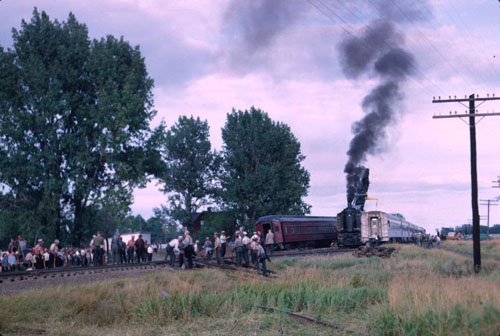 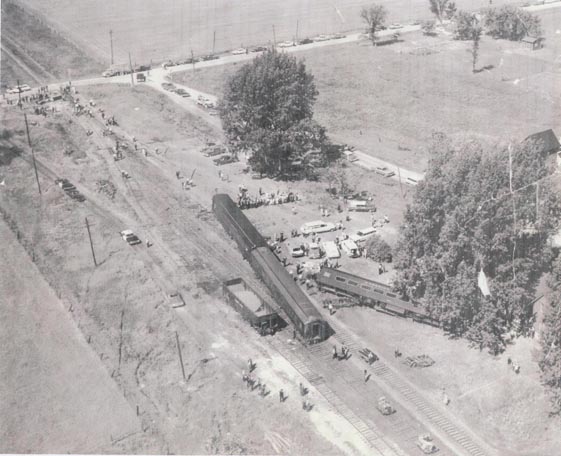 Ottawa Citizen 21 August 1964 Eight Die in Train Wreck 'A woman wass crying: Help me' By Bob Rupert Citizen staff writer LEONARD "I was lucky-the woman beside me died." These were the sad remarks of 58-year-old Hull chef Dominique Galgery at the scene of this tragic derailment. Galgery, who was sitting near the middle of a CPR train to Montreal, said "All of a sudden the gravel was flying and the people were falling out the windows. Moaning and screaming "They were moaning and screaming as I came out a window. My hat is still in there." A stout oak tree may have saved the life of widow Mrs. Jane Wood who lives alone in a house 60 feet north of the track. One of the rolling cars stopped against the tree less than 15 feet from her back porch. "I was in bed," said Mrs. Wood. "I heard a crash and I heard the women crying. "When I got to the porch they were sitting there bleeding something terrible. There was a nun that was in awful pain. She was moaning and making an awful noise." Pump house smashed Mrs. Melvin Larmour, who lives about 50 yards from the track, said she was just getting ready to bake bread "when I heard the bang and saw the smoke. "I said to my granddaughter, 'there's been a wreck', and right away I saw the pump house had been smashed. "One woman was crying 'help me, help me, help me'. I got blankets and covered her I did what I could." Witnesses said the injured and dying were treated at the scene by Dr. I. F. Kennedy of Cumberland. Assisting him shortly before a squadron of ambulances arrived were Dr. William Tweedy, district coroner, and Dr. Addy Power of Rockland. One witness said a priest was lying on the ground with one of his legs severed at the knee. The priest told doctors "I'm all right." Trainman W. C. Yendall said No. 232 was due to arrive in Montreal at 10 a.m. "I was at the front of the train and I got it stopped. Then I cam back." When The Citzen asked Mr. Yendall what he had seen, he pointed to the body of the truck driver and said "You see that? There are more of them up there." Gladys Barnes of 30 Walker St., Hull, trudged down the track, her battered suitcase in hand, and breathed "I was fortunate it was a miracle. "I was in the parlor car and there was a great flash. Flames were coming from both sides. The old gentleman beside me rolled along the aisle and smashed his head against a window. "People were lying half in and half out the windows, screaming." Miss Barnes, a National Film Board employee, was going to Montreal to attend a board meeting this morning. Truck derails cars, 30 hurt By Joe Finn Citizen staff writer LEONARD Eight persons were killed and upwards of 30 were injured today when a gravel truck crashed into the side of one of the coaches of the fast CPR Ottawa-Montreal flyer here at 8.15 a.m. Four cars of the train which left Ottawa at 7.55 a.m. were derailed. Most of the dead and injured were passengers riding in a sealed coach fourth from the rear of the train. Impact lifts coaches off tracks Leonard is 20 miles east of Ottawa. The truck driver was killed instantly The other seven dead were passengers. Victims identified at press time were: Basil Czopyk, about 30, of 330 Friel St., Ottawa, the truck driver. Sister St. Eliza, Mount St. Bernard, Antigonish, N.S.,1 Andre Roy, Quebec City. The gravel truck, going north, smashed into the side of car N. 2294 at the crossing in the centre of the village. The rear part of the train lifted from the tracks and tore up more than 150 yards of right of way. The truck carried seven to eight tons of gravel. The crossing is marked with a white "X" warning sign only. It was the worst accident in the history of the village. Some bodies were thrown clear of car 2294 which was titled at a crazy angle and jammed against a big elm tree 20 feet from the home of Mrs. Jane Wood. The other three coaches derailed stayed upright. It was a scene of horror. Screams rose from the shattered fifth car, where most of the dead were found. Flames licked round rear coaches, terrifying passengers trapped inside. Injured passengers, their hands and faces torn and bloody, crawled through shattered windows and collapsed on the ground. Villagers Help Carry Out Bodies One woman knelt on the ground with her arms around a woman's body shouting, "This is my sister! This is my sister!' A witness said there were "bits and pieces of people" lying all around. A small boy saw his mother and father die. A witness said he heard some priests praying as they lay dying or critically injured. Mrs. Jane Wood who lives beside the crossing, said she was lying in bed awake when she heard the screech of the air whistle of the diesel locomotive of the flyer. "Seconds later I heard a terrible, grinding crash. I jumped out of bed and ran to the window and there seemed to be dust and smoke everywhere in the air. "The smoke cleared and I saw one of the railroad coaches up against the tree almost outside my window. I could hear women screaming and men shouting for help. "It was the worst experience of my life." The scene in the village was one of wild confusion following the crash. Villagers hurried to the scene and helped members of the tiain crew carry the dead, dying and injured from the smashed coaches. Ottawa Citizen 22 August 1964 Police finish identification of 8 vistims The grim task of formally identifying the eight victims of Friday morning's train-truck crash at Leonard was still being carried out by police today. Some were so badly mangled and slashed by the heavy plate glass used in railway coaches that identification was made through names in clothing and tell-tale physical characteristics. 'They had been cut to pieces' "They had been cut to pieces," said Const. Ronald Collins of the Rockland Ontario Provincial Police detachment, one of the first at the scene. It was Const. Collins' job to see that all severed limbs were assembled with the proper torsos. The dead have been identified as: Basil Czopyk, 43, who roomed at 330 Friel St. and driver of the gravel truck that smashed into the fast -moving Ottawa - Montreal flyer. Sister St. Eiiza, 46, a Roman Catholic nun of the Congregation of Notre Dame, returning to St. Bernard College, Antigonish, N.S. Sister Marie de St. Maurice, 63, general bursar for the Sisters of Joan of Arc at the Ottawa Institute of Joan of Arc. Mhs. John Palmer, 37, of 196 Metcalfe St., Ottawa, on her way to visit a friend in Montreal. Mrs. Jean Poulin, 39, of Quebec City, returning home after a visit with her sister in Ottawa. Monique Roy, 51, of St. Gervais, Quebec, and her nephew, Andre Roy, 18, also of St. Ger-vais. Both were returning home after visiting a relative in Ottawa. Dimitrius Georgiles, 41, a civil servant with the forestry -department going to Montreal to write his final two university exams. Performed amputation at scene Twenty -three persons were injured, two seriously. Fourteen were admitted to hospital. Dr. I. F. Kennedy of Cumberland performed an emergency leg amputation at the scene. Doctors William Tweedy and Addy Power, both of Rockland, also rushed to the site to treat the injured and dying. The collision occurred about 8.20 a.m., 25 minutes after the non-stop train left Union Station. It was 1 p.m. before railway emergency crews, using acetylene torches, freed the last body from the wreckage. The northbound truck, loaded with seven to eight tons of gravel for roadwork under way at nearby Navan, rammed into the last coach, knocking it off the track. The coach, carrying about 35 passengers, careened wildly along the roadbed for 300 feet, coming to rest at a dangerous angle against a huge poplar tree. The diner and parlor car also jumped the track but remained upright. All railway passenger victims had been in the coach car. The undamaged section of the train later continued on to Montreal, arriving at the Montreal West station at 12.33 p.m., one hour and 48 minutes behind schedule. Swerved to left at last minute An inquest will be held into the death of the truck driver. Its findings will cover the deaths of the other seven victims. Police were not able to explain why Czopyk did not see the train. The Fifth Line, on which the truck was travelling, crosses the tracks at right angles with nothing to impair a driver's vision. Const. Collins said there were no skid marks but Czopyk had swerved to the left in a last minute attempt to avoid a collision. A passenger said the truck ran into the ditch and up the other side, striking the fourth coach high up. The rear of the truck then swung around, smashing into the train between the coach and diner. Trucks had been hauling gravel along the road for several weeks and residents of the area had complained amongst themselves about the speed at which they travelled along the gravel road. Ottawa Citizen 22 August 1964 Decision to eat saves city train passenger Miss Myra Slack, 17, daughter of Mr. and Mrs. Lou Slack, 479 Penhill Ave., was seated in a coach but decided to go to the dining car. She was in the car a short time when the accident occurred. She thinks the move probably saved her live (sic). She called her mother from Cumberland following the wreck. Neither Mr. or Mrs. Slack had heard of the tragedy when their daughter called to say she was safe. Ottawa Citizen 30 October 1964 Train speeding 70 when hit by truck ROCKLAND - CPR Ottawa-Montreal express No. 232 was travelling with throttles wide open at 70 miles an hour when it was struck by a loaded gravel truck at the Leonard level crossing Aug. 21, killing eight. At an inquest which opened here today into the death of 43-year-old truck driver, Bazyl Czopyk, CPR engineer John Arden Simpson, 47, told a corner's jury: "We were running it as fast as the engines would take us the throttles were open all the way." St. Louis Marie de Montfort Hospital pathologist Dr. Peter Burke, who performed an autopsy, said Czotyk "had nothing left to live with many of his injuries could have been fatal." Among the injuries he listed were: a fractured skull with half of the brain missing, fractured neck, broken back, spine torn in half, left arm and leg broken, several ribs smashed, heart and both lungs ruptured, and ruptures to the liver and spleen. Leonard farmer Jack Neely, 29, said he followed Czopyk's truck along Russell County Road No. "I was travelling 35-40 miles an hour and the truck was pulling away from me," said Neely. "I saw the truck veer suddenly to the right; it didn't stop. I saw no brake lighs(sic)," he said, esimating the rucks(sic) speed a 50 miles an hour. Cumberland Township Clerk Robert J. Kennedy, 70, whose office in Leonard is 150 feet from the crossing, said he remembered the fatal morning clearly. "I head the crash and saw the train go by with flames running under it," he said. "We were expecting an accident there. They had been driving very fast. A week before, a truck left the road to avoid an accident at the same place. "I searched my brain trying to find a way to stop them I'm sorry now that I didn't phone the police." more more more more more Train conductor Edward Mc-Mullin, 50, of Ottawa, said the train left Ottawa at 8 a.m., five minutes lae(sic). He said the train usually ran non - stop to Montreal at speeds up to 75 miles per hour. However, Engineer Simpson said 85 miles per hour is top speed for the run. The inquest continues. Ottawa Citizen 31 October 1964 Driver blamed in train crash By Bob Rupert Citizen staff writer ROCKLAND - Bazyl Czopyk, 42-year-old trucker who drove his loaded vehicle into the side of a fast-moving Canadian Pacific passenger train Aug. 21, has been blamed for the tragic accident which claimed eight lives including his own. A coroner's jury deliberated for less than an hour here Friday before finding that Czopyk contributed to his own death by failing to use proper care and caution when approaching the level crossing on the northern border of the village of Leonard. In part, the verdict read: "We find this fatal accident, which took eight lives and caused so much personal injury, was due to Mr. Bazyl Czopyk driving his loaded gravel truck into the side of an eastbound passenger train. His death was caused by multiple injuries, lacerations and loss of blood. "... We the jurors recommend that a suitable automatic signal be installed at this crossing." Thirteen testify Thirteen witnesses, five of them survivors of the early-morning crash which injured 31, were called to testify before Russell County Coroner Dr. W. C. Tweedie. Jack Neely, 29-year-old Leonard farmer, said he followed Czopyk's loaded gravel truck along County Road No. 4 on the fateful morning. "I was travelling 35 to 40 miles an hour and the truck was pulling away from me," said Neely. "I saw the truck veer suddenly to the right. It didn't stop. I saw no brake lights," added the eye witness, who estimated the truck's speed at about 50 mph. CPR engineer John Arden Simpson, 47, of Ottawa, said top speed on the run is 85 mph. He said the speed at the time of the crash was 70 mph. Mara Karnupe, 36-year-old Montreal librarian who was sitting in the third coach of the seven-car train when the truck slammed into its side, said she saw the oncoming truck at the last minute. "I knew we would be hit," she testified. "It was moving too fast it couldn't possibly stop. "I was thrown down on the floor, then onto the seat opposite mine. Then I felt the car tip sharply and I saw something green. "I felt myself being thrown and I was lying on the grass. I got up and ran forward. I was afraid the train (listing at a 45-degree angle against a tree) would keep rolling and crush me underneath. "All the windows were smashed. People were lying all ever the place." . Miss Karnupe spent five days in hospital recovering from minor injuries. Allan Dobson, 18, of North Gower, and Peter Hopkins, 21, of 251 Fifth Ave., both students working at Rathwell's gravel pit a mile south of Leonard, said the Czopyk truck was noisy, possibly from a faulty muffler. Truck owner Joe Ambrozas of Ramsayville said his vehicle was in good working condition. He said Czopyk had been driving the two-year-old truck for two consecutive summers. He described Czopyk as "a very good driver" who never had an accident while in his employ. Ontario Provincial Police Const. R. E. Collins of the Rockland detachment said the westward view from County Road No. 4 for drivers in the village is "almost entirely blocked" to within 50 feet of the edge of the track by buildings and hedges. Const. Collins said he had been unable to find next-of-kin to notify of Czopyk's death. The constable said the truck driver probably tried to turn his truck at the last minute to avoid the collision. Ottawa Journal 29 April 1972 Extract from Senseless Sacrifice by Heward Grafftey IT WAS A sunny day on Friday, Aug. 21, 1964, when I left my Ottawa apartment about 7 AM to board an east-bound Canadian Pacific train for Montreal. About the same time as the train pulled out of Ottawa's Union Station, Basil Czopyk was driving his truck, full of gravel, toward Leonard, Ont., a small village on the CP rail line between Ottawa and Montreal. Czopyk usually stopped for coffee at Leonard. From time to time he boasted how he raced and beat the early morning train over the rail intersection in the middle of this quiet hamlet. This particular Friday morning, he wasn't going to make it. My train picked up speed as it left the outskirts of Ottawa. Twenty minutes after departure we were hitting around 70 mph. I had taken a chair in the dining car to eat breakfast and read the newspaper. Then it happened. The car began to pitch and lunge. People and furniture were thrown everywhere. Orange and yellow flames enveloped the windows. I was thrown the length of the car with other diners. Finally it came to a crashing halt at an acute angle. I scrambled out and jumped onto the gravel rail bed. It was hard, at first, to understand just what had happened. In front of me was the wreckage of a truck amid a pile of gravel. Czopyk had driven into the middle of the train. He was killed instantly. The engine and front cars continued on. The car he hit left the tracks and turned end over end before falling on its side in a nearby field. Those in the dining car, including myself, and in another car at the rear of the train were fortunate. Automatic brakes went on and while many were shaken up as these two cars ripped up 100 yards of track, many injuries were prevented and lives saved. But the car that was hit lay on its side near an old farm shed. I could hear screams and moans. Sliding down the embankment to the scene, I could see what had happened. As the car spun in mid-air, many people were tossed through broken windows, then the car rolled over and crushed them. It was difficult to tell who was dead and who was injured. A stunned trainman attempted to set up communications with some equipment which he attached to the tracks. I ran to a nearby farmhouse and on an old crank phone told the operator of the accident, asking for ambulances. Forty minutes later, a country doctor arrived. Helicopters from the news media hovered over the scene. Finally, more than one hour after the accident, one privately owned ambulance appeared. I don't know when the last victim was removed, but many seriously injured passengers still lay in the field more than two hours after the crash. And we were not in some isolated wilderness, but only 20 minutes from our nation's capital. The final toll: eight dead and more than 20 seriously injured. |

Return to Main Page of Railway Accidents
Updated 22 April 2020
